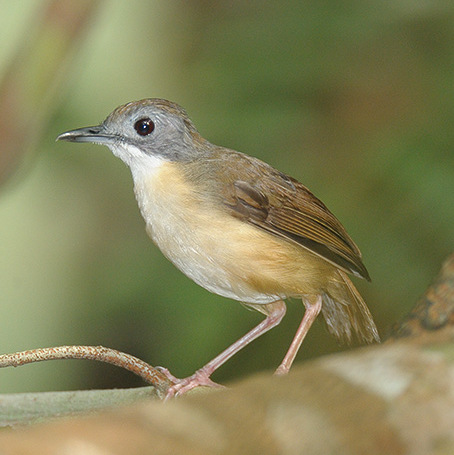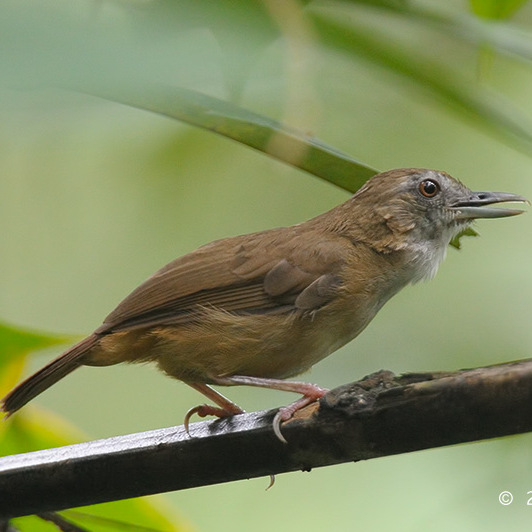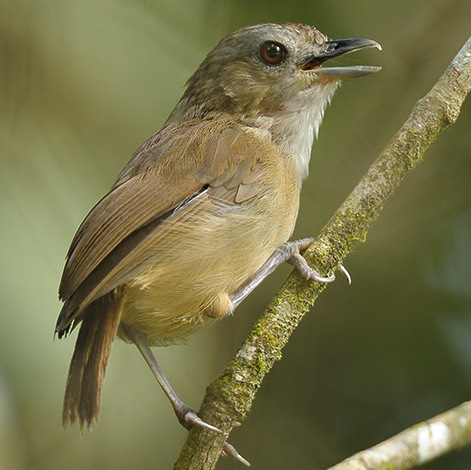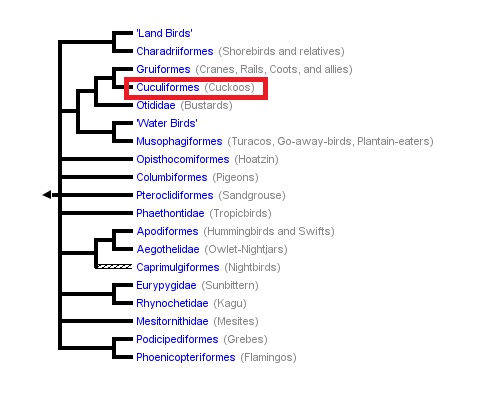Table of Contents
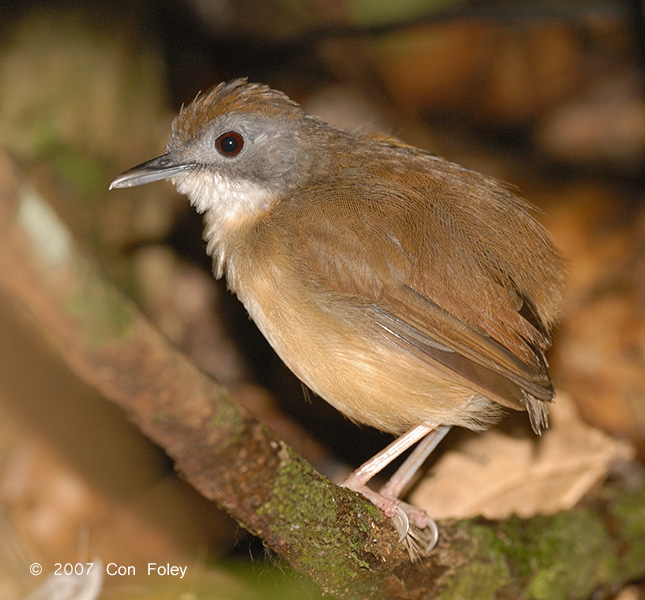 |
| Photograph by Con Foley (2007) |
Introduction
The Short-tailed Babbler is an insectivorous, understorey bird of the Sundaic lowlands. It is one of the five babblers that survived massive deforestation in Singapore over the past two centuries which led to the extirpation of eight other babbler species[1] . It is a forest specialist and although it is a fairly common resident of Singapore's Central Catchment Nature Reserve, it is threatened by habitat loss throughout its Southeast Asian range. In Singapore, one of the major threats it faces is the proposed construction of the Cross-Island line which will fragment its already limited local range*. It is a polytopic species (meaning that it has many sub-species) with only one sub-species found in Singapore (Pellorneum malaccense malaccense)[2] . It was formerly known as Malacocincla malaccensis, but recent genetic data suggests that its taxonomic placement be revised to Pellorneum malaccense[3] .*To sign a petition proposing to re-route the Cross-Island Line such that it will not affect the habitat of the Short-tailed Babbler and other forest specialists, please click here.
Etymology
The genus name Pellorneum is derived from the Latin word pellos, meaning dark coloured; combined with orneon, meaning bird. The species name, malaccense, refers to Malacca, the Malaysian state from which the species was originally described[4] .Description
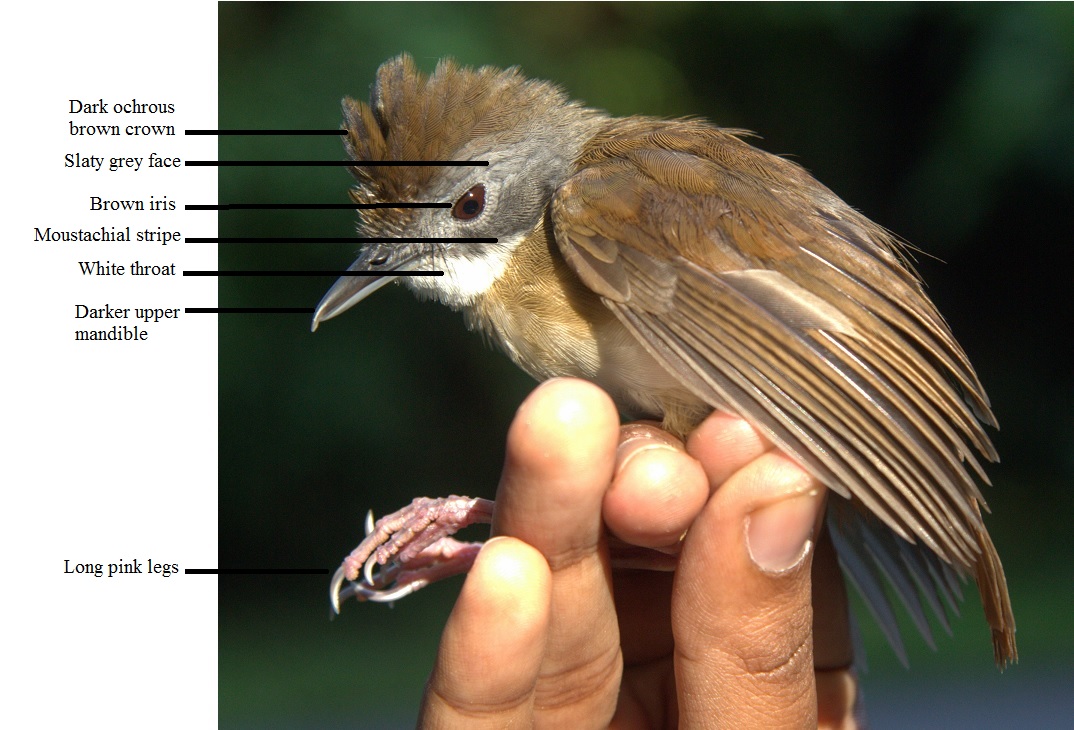 |
| Characteristic features of the Short-tailed Babbler (Photograph by Keren Sadanandan, 2013) |
The Short-tailed Babbler is a small-sized bird of 13.5 - 15.5cm[5] . Its distinguishing features include slaty grey face (including lores, supercilium, ear-coverts and neck side), demarcated from white throat by thin black moustachial stripe. White breast and belly: side of breast and flank washing onto the belly is pale tawny orange. Upper-parts dark olive-brown: crown slighter darker and more ochrous brown than the nape, mantle and back. Mantle is warm olive brown, shading progressively to tawny rufous from back to upper tail coverts. Tertials and inner secondaries similar to mantle but outer-webs fringed slightly more rufescent[6] [7] . Slightly darker grey under eye which blends into black moustachial stripe. Iris red to brown; upper mandible is blackish and darker than lower mandible. It possesses relatively long pinkish legs and a very short dark chestnut tail fringed brighter chestnut. [8] . Body is slightly rounded in shape[9] .
Sexes similar but females are slightly smaller in size[10] .
Juveniles are similar to adults, but have browner head sides, paler brown cap, yellow gape, ochrous-buff throat and fringes of primaries are rusty coloured[11] [12] .
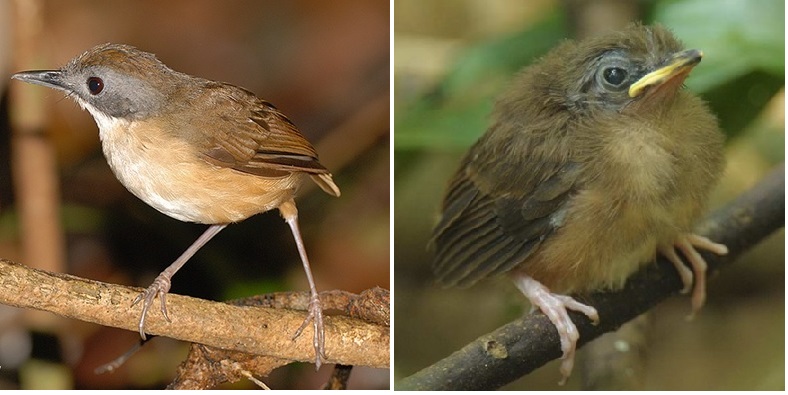 |
| Short-Tailed Babblers showing varying form and plumage during different life stages: adult(left) and juvenile (right). Photographs by Con Foley. |
Diagnosis
It can be distinguished from the similar looking Abbott's Babbler (Malacocincla abbotti) by the presence of a black moustache, stronger grey facial coloration and shorter tail.Possesses brighter plummage and less robust bill than closely related Horsfield's Babbler (Malacocincla sepiaria)[13] .
| Short-tailed Babbler[14] |
Abbott's Babbler[15] |
Horsfield's Babbler[16] |
||||||
|
|
|
||||||
|
|
|
Calls
Short-tailed Babblers are more often heard than seen and their call is a distinctive series of loud descending whistles: pi'pi'pi'pi'pi pew pew pew pew pew pew. This song is repeated regularly in the early hours of the morning. Vocalization is not often heard at latter parts of the day. Loud singing may indicate either advertising or patrolling of territories[17] .The alarm call comprises harsh, mechanical sounding chututututut [18] .
For more Short-tailed Babbler calls, please refer to thislink [19] .
For an acoustic analysis of the Short-tailed Babbler call, please click here.
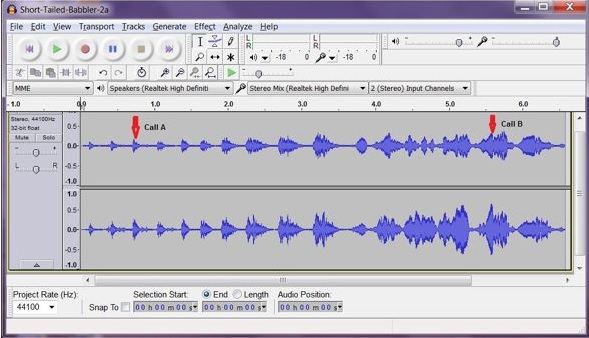
Biology
Behaviour
The species is an insectivorous understorey bird displaying territorial behaviour and is usually seen foraging singly or in pairs with a juvenile [20] . It is most frequently sighted hopping or skulking in the undergrowth at ground or eye level [21] [22] . Individuals are usually active at daybreak, up to about 9.00am, or just after rain. It is a non-migratory species and like most species under the Pellorneinae subfamily, it has short, rounded wings and weak flight[23] .Feeding
Their diet includes a variety of insects including beetles (Coleoptera), small grasshoppers (Orthoptera) and ants (Formicidae). They often use their feet to grasp prey items [24] and forage on or just above the ground, usually in pairs[25] .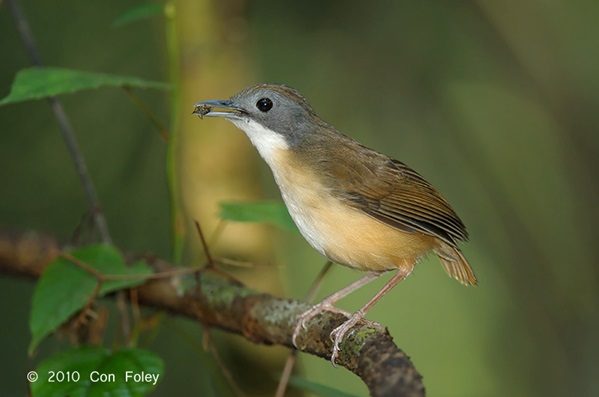 |
| The Short-tailed Babbler feeding (Photograph by Con Foley, 2010) |
Nesting
The nest is a small cup built not more than 0.3m above the forest floor with a clutch of 2-3 eggs. Nests are usually made of dead leaves, root fibres, twigs and leaves and are lined with grassy materials and/or long roots and tendrils. Nests built above ground are usually constructed on fallen branches or small saplings whilst those on ground are nestled within tree roots or dead leaf matter[26] . Nest building has been reported in late January[27] .Eggs are ovate and pale beige to dark pink in colour with brown/mauve markings[28] .
Breeding
Breeding is reported from February to September across range. May have several batches of young in one breeding season[29] .Moult
Estimated to take 14-18 weeks. Wing and tail usually moult simultaneously. Moulting reported from late April to December. During moulting, adjacent feathers may be seen in overlapping growth[30] .Range
The species occurs across the Thai-Malay peninsula and Indonesia up to about 915m [31] .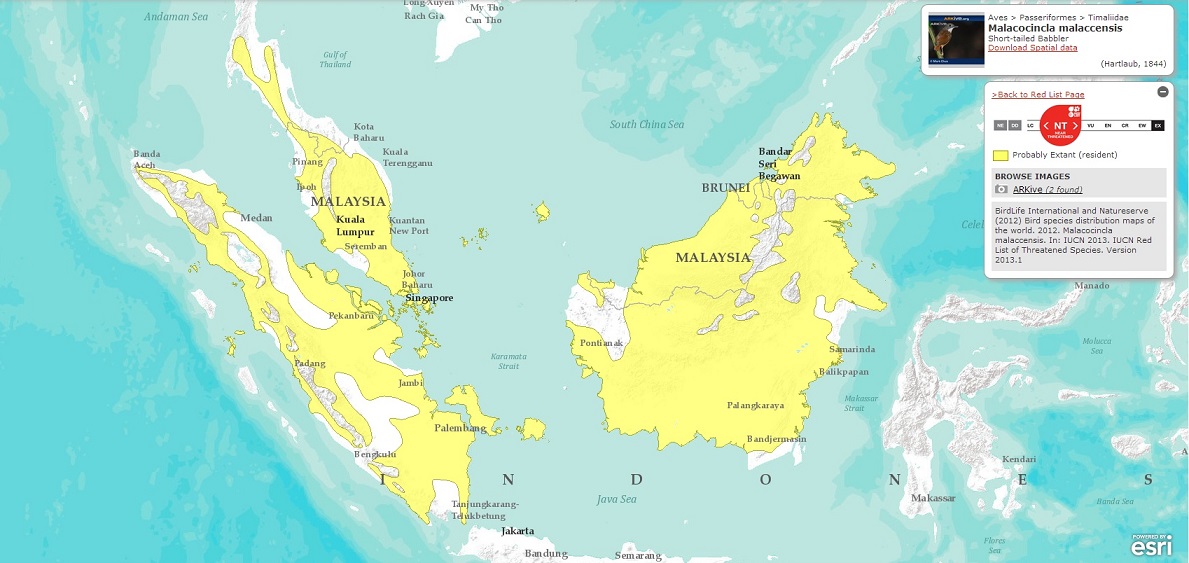 |
| Map of Southeast Asia with Short-tailed Babbler distribution indicated in yellow (IUCN, 2013) |
Habitat
The species has been recorded in a number of different habitat types,including primary broadleaf evergreen forest, mature secondary forest, drier parts of peat swamp forests, stream edges, scrubs, thickets and overgrown plantations[32] .Distribution in Singapore
Within Singapore, it only occurs in certain patches of the Central Catchment Nature Reserve (including MacRitchie, Upper Peirce, Upper Seletar, Mandai and Nee Soon swamp forest) and Bukit Timah Nature Reserve which contain primary or mature secondary forest [33] [34] . It is often found near streams and freshwater swampy habitats [35] [36] . It is the only stenotopic (i.e. forest-specific) babbler in Singapore which is not locally threatened although it no longer occurs in places where it was previously common, such as the Singapore Botanic Gardens[37] . The population in Bukit Timah Nature Reserve is also reported to have declined over the past decade [38] [39] .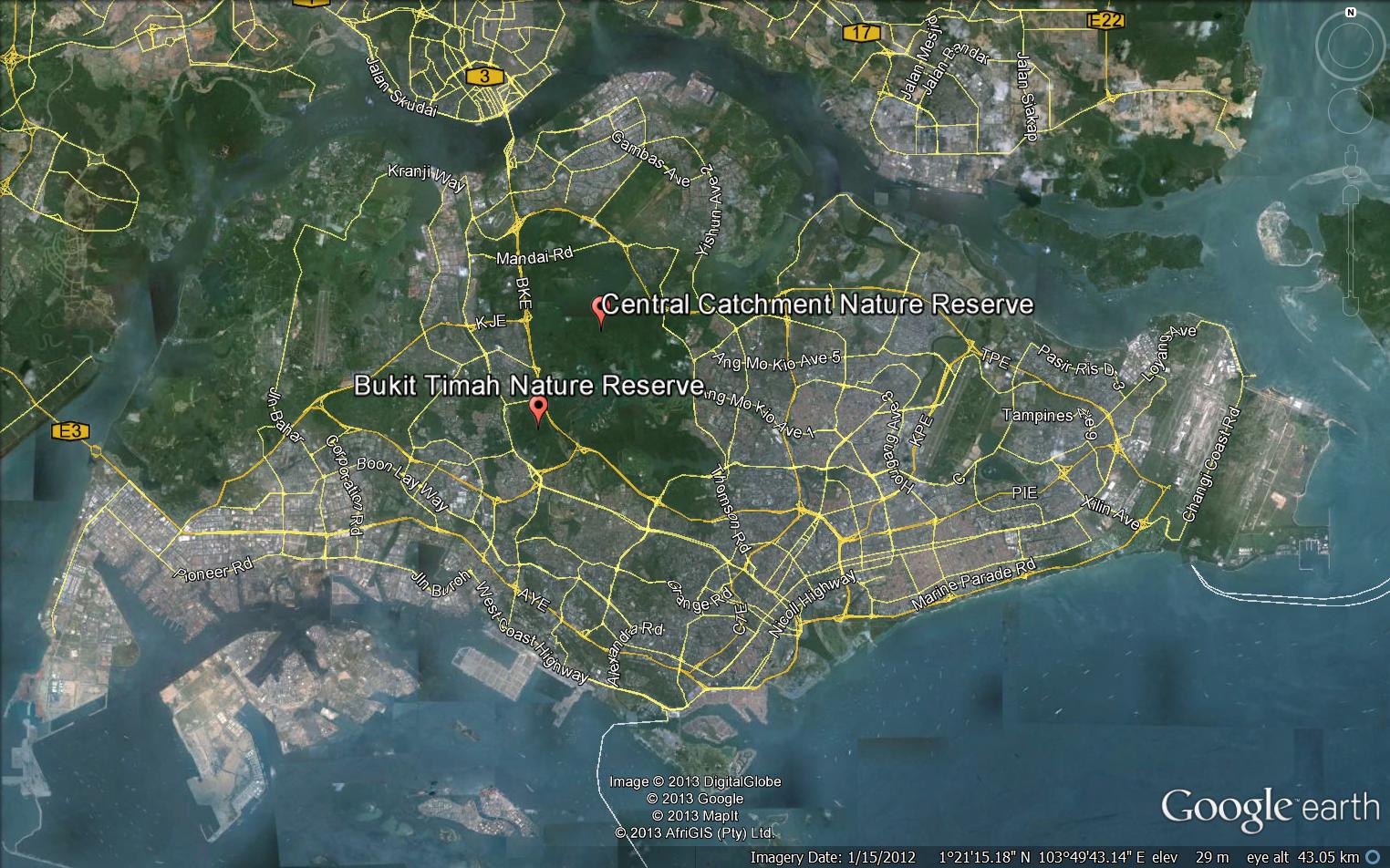 |
| Map of Singapore indicating the nature reserves within which the Short-tailed Babbler can be found. Google Maps. (2013) |
Conservation
IUCN StatusThe species is classified as Near Threatened (NT) on the IUCN Red List and the NSS bird survey of 2005 reports that the population in Singapore is declining [40] . However, the species is considered as fairly common to common throughout its Southeast Asian range[41] .
Threats
Although population trends for the region have not been quantified, it is likely that populations are declining on account of degradation and loss of Sundaic lowland forest [42] . Logging, land conversion and forest fires are cited as key causes for population decline [43] . However, the impact of such threats may be reduced by the species ability to adapt to secondary growth forest and hill slopes.
Threats in Singapore
The proposed construction of the new MRT line, the Cross-Island line, which will span from Jurong Industrial Estate to Changi[44] , will disturb and cut through several patches where the Short-tailed Babbler occurs and thus may pose a threat to the local population[45] . Short-tailed Babblers are forest specialists and are therefore quite sensitive to the effects of both disturbance and habitat fragmentation, particularly as they have low dispersal abilities.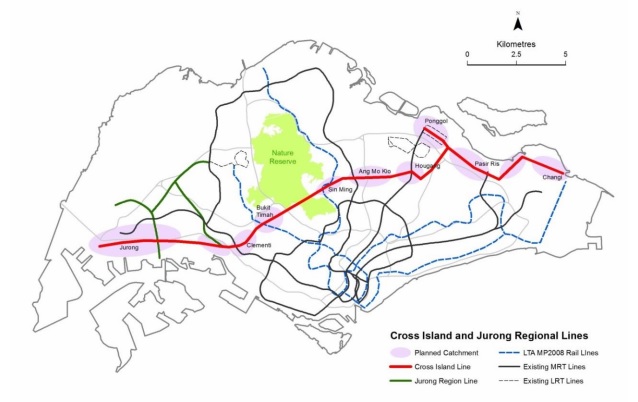 |
| Proposed route for the Cross Island Line, which bisects both Bukit Timah and Central Catchment Nature Reserve (source: Nature Society [Singapore], 2013) |
The Nature Society of Singapore has proposed an alternative route in a 40 page position paper. The paper may be accessed by clicking on the excerpt below which details potentially affected avian species:
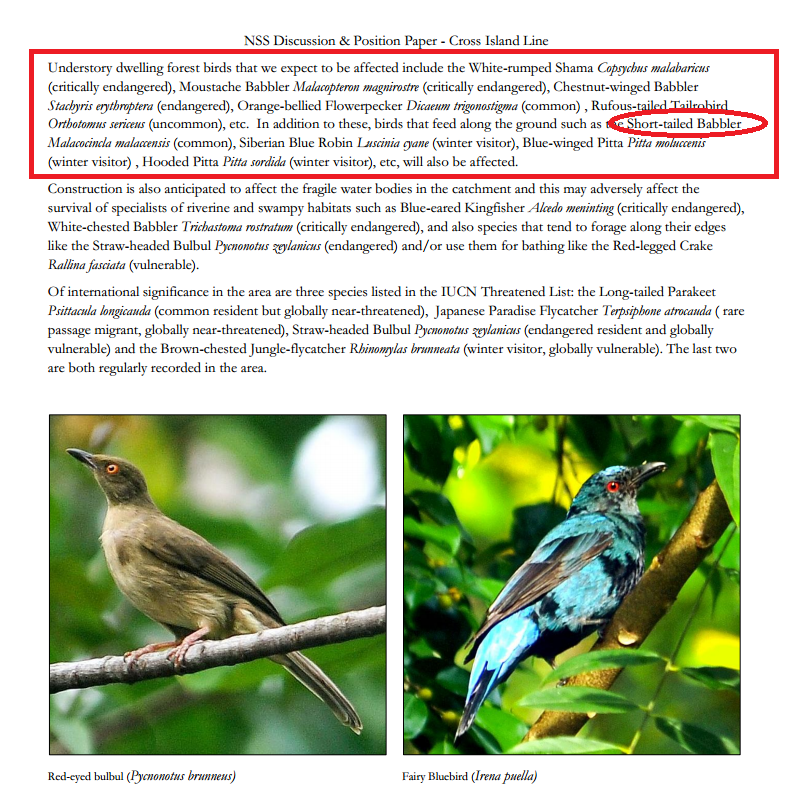
To sign the petition appealing to re-route the proposed Cross-Island line so as not to cut across the nature reserve, click here.
Taxonomy
A hierarchical summary of the taxa within which the Short-tailed Babbler is placed is provided below:| Animalia |
| Chordata |
| Aves |
| Passeriformes |
| Timaliidae |
| Pellorneinae |
| Pellorneum |
| P. malaccense (Hartlaub, 1844) |
Proposed subspecies[46]
| Subspecies |
Status |
Notes |
| P. m. malaccense (Hartlaub, 1844) |
Valid |
Nominate subspecies |
| P. m. poliogenys (Strickland, 1849) |
Valid |
|
| P. m. sordida (Chasen & Kloss, 1929) |
Invalid |
Synonymous with P. m. poliogenys |
| P. m. feriata (Chasen & Kloss, 1931) |
Invalid |
|
| P. m. saturata |
Invalid |
Synonymous with P. m. poliogenys |
It forms a superspecies with the Ashy-headed Babbler, Pellorneum cinereiceps (meaning that they are very closely related but separate species); it was previously suggested that the two species were conspecific, but recent vocalization and genetic data suggests otherwise[50] .
Geographically separate populations in Borneo have been proposed as sub-species, but inter-population variation is slight, which has led to the synonymization of the proposed races sordida[51] (NE Borneo) and saturata (Bangka, Belitung and W Borneo) with poliogenys. The proposed feriata race[52] appears to exhibit features characteristic of the juveniles of the species and is not recognized[53] . Thus, only two sub-species are recognized, with P. m. malaccensis found in Singapore, Peninsular Malaysia, Southern Thailand, Sumatra and its islands, the Anambas and North Natuna islands, and P. m. poliogenys distributed across Bangka, Belitung and Borneo[54] . It is of importance to note that the validity of hierarchical groupings such as subspecies is a controversial topic and is not supported by many of the proposed species concepts[55] .
Synonyms for Pellorneum malaccense include Malacocincla malaccensis, Malacocincla malaccense, Trichastima malaccense and Trichastoma malaccensis [56] . It is sometimes called the Short-tailed Jungle Babbler [57] .
Interestingly, the species was also originally classified under the Brachypteryx genus and subsequently shifted to Trichastoma and then Malacocincla. However, a recent paper by Moyle et al. (2012) provided evidence for a shift from the genus Malacocincla to Pellorneum (see section on Phylogeny below).
Type
The species was originally described by Gustav Hartlaub in 1844 in Systematisches Verzeichniss der naturhistorichen Sammlung der Gesellschaft Museum (not available online). The type information for the species is as follows[58] :
Type for Malacocincla malaccensis malaccensis
Catalogue Number: USNM 169877
Collection: Smithsonian Institution, National Museum of Natural History, Department of Vertebrate Zoology, Division of Birds
Sex/Stage: Male; Adult
Preparation: Skin: Whole
Collector(s): W. Abbott
Year Collected: 1899
Locality: Khao Soi Dao, Trang, Thailand, Asia
Phylogeny
The placement of babblers on the avian tree of life is shown below, illustrating relatively recent divergence times. Note that the radius of the branch on the tree corresponds to evolutionary time. Thus the oldest lineages of birds are the paleognaths at the 3 o'clock position and subsequent avian evolution moves in an anti-clockwise direction from that position.Systematics of old world Babblers (Timaliidae) have been heavily contested. In the 20th century, the family was used as a 'wastebin taxon' for numerous hard-to-place Old World songbirds. The advancement of DNA sequencing technologies has shed light on some of the relationships amongst species within this taxon and thus the taxa is currently in flux with numerous revisions being proposed. For example, the Short-tailed Babbler was long regarded as belonging to the Malacocincla genus, as sister species to the Abbott's babbler (Malacocincla abbotti) and Horsfield's Babbler (Malacocincla sepiaria). However, a study by Moyle et al. (2012) which analyzed a data set of six genes (3 nuclear and 3 mitochondrial) provided high support for the placement of the Short-tailed Babbler in the Pellorneum genus, as a sister species to Ashy-headed Babbler (Pellorneum cinereiceps, previously Malacocincla cinereiceps)[59] .
The results of the study are shown below:
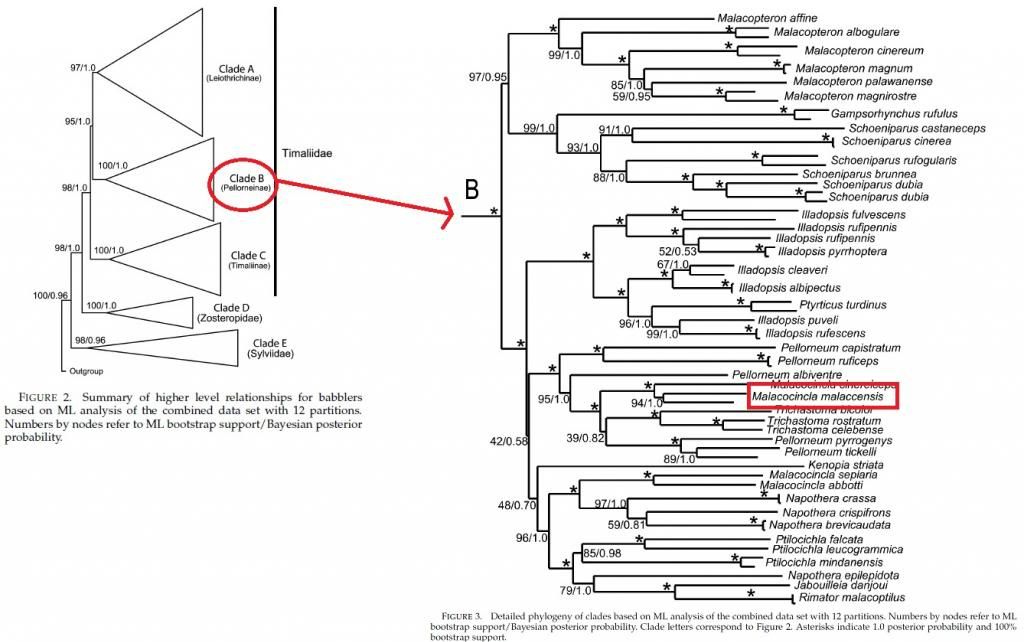
For further information, please refer http://www.ncbi.nlm.nih.gov/pubmed/22328569
The following gene sequences for the species are available on GenBank (do note that they are filed under the old species name, Malacocincla malaccensis): TBFB2, CYTB, ND3, ND2, Fib5, MUSK, GAPDH1-2. Currently, no DNA barcode data exists for the species.
References
Yong, D. L. (2009). Persistence of babbler (timaliidae) communities in singapore forests. Nature in Singapore, 2, 365-371.
Jobling, J. A. (2009). Helm dictionary of scientific bird names. (1st ed.). Christopher Helm Publishers Ltd.
Robson, C. (2007). New holland field guide to the birds of southeast asia. (p. 248). London: New Holland Publishers (UK) Ltd.
Wells, D. R. (2007). The birds of the thai-malay peninsula. California; London: Academic Press.
Collar, N. J., and C. Robson. 2007. Family Timaliidae (babblers) in del Hoyo J., Elliott A., and Christie D. A. eds. Handbook of the birds of the world. Volume 12. Picathartes to Tits and Chickadees. Lynx Edicions, Barcelona. Pp 70-291.
Jeyarajasingham, A., & Pearson, A. (1999). A field guide to the birds of west malaysia and singapore. New York: Oxford University Press.
Wells, D. R. (2007). The birds of the thai-malay peninsula. California; London: Academic Press.
Robson, C. (2007). New holland field guide to the birds of southeast asia. (p. 248). London: New Holland Publishers (UK) Ltd.
Xeno-canto, undated. All Species In The Collection. Xeno-canto Foundation. http://xeno-canto.org/all_species.php. Accessed 12 Nov 2013.
The Global Biodiversity Information Facility: GBIF Backbone Taxonomy, 2013-07-01. Accessed via http://www.gbif.org/species/2493400 on 2013-11-10
The Global Biodiversity Information Facility: GBIF Backbone Taxonomy, 2013-07-01. Accessed via http://www.gbif.org/species/2493400 on 2013-11-10
Collar, N. J., and C. Robson. 2007. Family Timaliidae (babblers) in del Hoyo J., Elliott A., and Christie D. A. eds. Handbook of the birds of the world. Volume 12. Picathartes to Tits and Chickadees. Lynx Edicions, Barcelona. Pp 70-291.
Collar, N. J., and C. Robson. 2007. Family Timaliidae (babblers) in del Hoyo J., Elliott A., and Christie D. A. eds. Handbook of the birds of the world. Volume 12. Picathartes to Tits and Chickadees. Lynx Edicions, Barcelona. Pp 70-291.
Collar, N. J., and C. Robson. 2007. Family Timaliidae (babblers) in del Hoyo J., Elliott A., and Christie D. A. eds. Handbook of the birds of the world. Volume 12. Picathartes to Tits and Chickadees. Lynx Edicions, Barcelona. Pp 70-291.
Wells, D. R. (2007). The birds of the thai-malay peninsula. California; London: Academic Press.
Robson, C. (2007). New holland field guide to the birds of southeast asia. (p. 248). London: New Holland Publishers (UK) Ltd.
Collar, N. J., and C. Robson. 2007. Family Timaliidae (babblers) in del Hoyo J., Elliott A., and Christie D. A. eds. Handbook of the birds of the world. Volume 12. Picathartes to Tits and Chickadees. Lynx Edicions, Barcelona. Pp 70-291.
Wang, L.K. & Hails, C.J. 2007. An annotated checklist of birds of Singapore. Raffles Bulletin of Zoology, Supplement 15: 1–179, Singapore.
BirdLife International 2012. Malacocincla malaccensis. In: IUCN 2013. IUCN Red List of Threatened Species. Version 2013.1. <www.iucnredlist.org>. Downloaded on 10/11/2013.
BirdLife International (2013) Species factsheet: Malacocincla malaccensis. Downloaded from http://www.birdlife.org on 10/11/2013.
Cross island line. Land Transport Authority, Retrieved from http://www.lta.gov.sg/content/ltaweb/en/public-transport/projects/cross-island-line.html. Accessed 14/11/2013.
Collar, N. J., and C. Robson. 2007. Family Timaliidae (babblers) in del Hoyo J., Elliott A., and Christie D. A. eds. Handbook of the birds of the world. Volume 12. Picathartes to Tits and Chickadees. Lynx Edicions, Barcelona. Pp 70-291.
Family: Pellorneidae. (2012). Oiseaux.net, available from http://www.oiseaux.net/birds/pellorneidae.html Accessed 10 Nov 2013
Collar, N. J., and C. Robson. 2007. Family Timaliidae (babblers) in del Hoyo J., Elliott A., and Christie D. A. eds. Handbook of the birds of the world. Volume 12. Picathartes to Tits and Chickadees. Lynx Edicions, Barcelona. Pp 70-291.
BioLib - Malacocincla malaccensis (Short-tailed Babbler) - Tree. Biological Library, available from http://www.biolib.cz/en/taxontree/id27050/ Accessed 10 Nov 2013.
Synonyms of Short-tailed Babbler (Malacocincla malaccensis). Encyclopedia of Life, available from http://eol.org/pages/1052280/names/synonymsAccessed 10 Nov 2013.
Facts about Short-tailed Babbler (Malacocincla malaccensis). Encyclopedia of Life, available from http://eol.org/pages/1052280/detailsAccessed 10 Nov 2013.
Moyle, R. G., Anderson, M. J., Oliveros, C. H., Steinheimer, F., & Reddy, S. (2012). Phylogeny and biogeography of the core babblers (aves: Timaliidae). Syst Biol, 61(4), 631-651.
